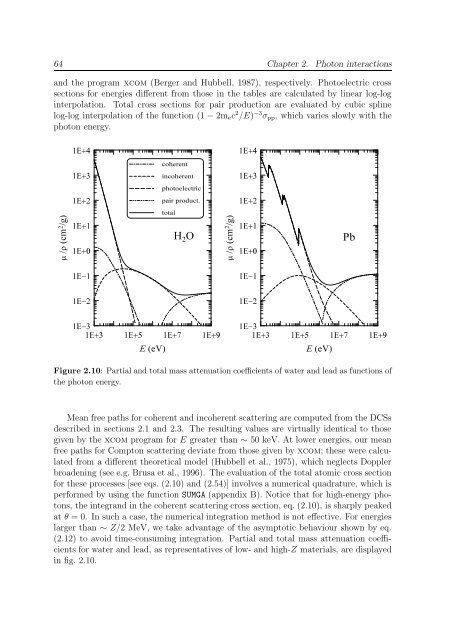PENELOPE 2003 - OECD Nuclear Energy Agency
PENELOPE 2003 - OECD Nuclear Energy Agency
PENELOPE 2003 - OECD Nuclear Energy Agency
You also want an ePaper? Increase the reach of your titles
YUMPU automatically turns print PDFs into web optimized ePapers that Google loves.
p<br />
l<br />
64 Chapter 2. Photon interactions<br />
and the program xcom (Berger and Hubbell, 1987), respectively. Photoelectric cross<br />
sections for energies different from those in the tables are calculated by linear log-log<br />
interpolation. Total cross sections for pair production are evaluated by cubic spline<br />
log-log interpolation of the function (1 − 2m e c 2 /E) −3 σ pp , which varies slowly with the<br />
photon energy.<br />
1Ε+4<br />
1Ε+4<br />
coherent<br />
1Ε+3<br />
i ncoherent<br />
1Ε+3<br />
hotoel ectri c<br />
1Ε+2<br />
p a i r p rod u ct.<br />
1Ε+2<br />
tota<br />
µ /ρ (cm 2 /g)<br />
1Ε+1<br />
1Ε+0<br />
H 2<br />
O<br />
µ /ρ (cm 2 /g)<br />
1Ε+1<br />
1Ε+0<br />
Pb<br />
1Ε− 1<br />
1Ε− 1<br />
1Ε− 2<br />
1Ε− 2<br />
1Ε− 3<br />
1Ε− 3<br />
1Ε+3 1Ε+4 1Ε+5 1Ε+6 1Ε+7 1Ε+8 1Ε+9<br />
1Ε+3 1Ε+4 1Ε+5 1Ε+6 1Ε+7 1Ε+8 1Ε+9<br />
E (eV)<br />
E (eV)<br />
Figure 2.10: Partial and total mass attenuation coefficients of water and lead as functions of<br />
the photon energy.<br />
Mean free paths for coherent and incoherent scattering are computed from the DCSs<br />
described in sections 2.1 and 2.3. The resulting values are virtually identical to those<br />
given by the xcom program for E greater than ∼ 50 keV. At lower energies, our mean<br />
free paths for Compton scattering deviate from those given by xcom; these were calculated<br />
from a different theoretical model (Hubbell et al., 1975), which neglects Doppler<br />
broadening (see e.g. Brusa et al., 1996). The evaluation of the total atomic cross section<br />
for these processes [see eqs. (2.10) and (2.54)] involves a numerical quadrature, which is<br />
performed by using the function SUMGA (appendix B). Notice that for high-energy photons,<br />
the integrand in the coherent scattering cross section, eq. (2.10), is sharply peaked<br />
at θ = 0. In such a case, the numerical integration method is not effective. For energies<br />
larger than ∼ Z/2 MeV, we take advantage of the asymptotic behaviour shown by eq.<br />
(2.12) to avoid time-consuming integration. Partial and total mass attenuation coefficients<br />
for water and lead, as representatives of low- and high-Z materials, are displayed<br />
in fig. 2.10.
















